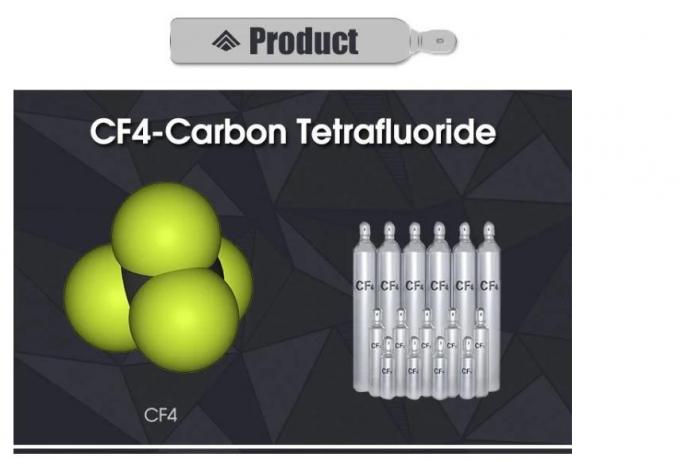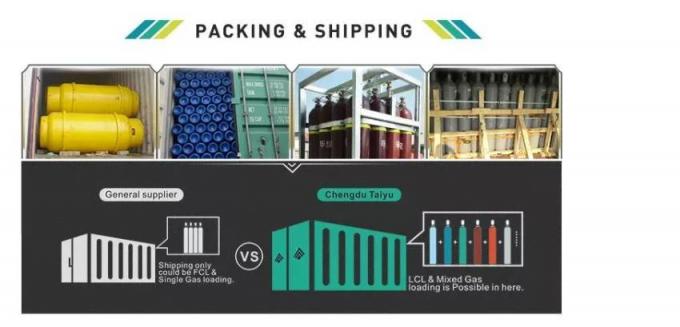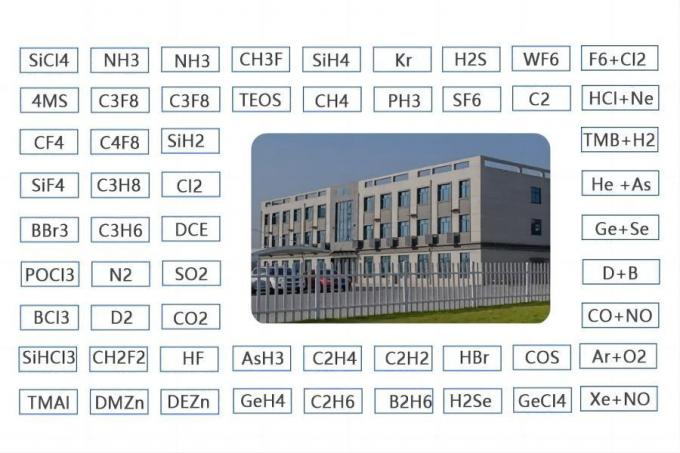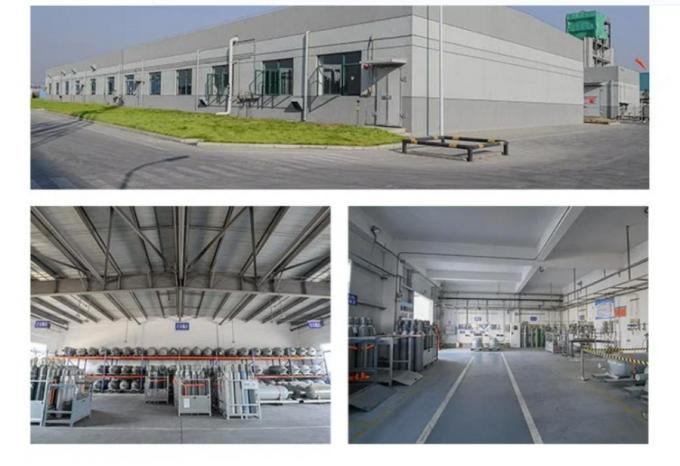


| MOQ: | 1kg |
| Price: | US $14/kg |
| Standard Packaging: | Cylinder/Tank |
| Delivery Period: | 15 days |
| Payment Method: | L/C, T/T |
| Supply Capacity: | 20000 Tons/Year |
Carbon tetrafluoride gas (CF4) is a colorless and odorless gas composed of one carbon atom bonded to four fluorine atoms. It is also known as tetrafluoromethane. Here are some key points about carbon tetrafluoride gas:
Properties: Carbon tetrafluoride gas possesses several important properties:
Production: Carbon tetrafluoride can be produced by the reaction of carbon or carbon-containing compounds with fluorine gas. It is also a byproduct of the aluminum smelting process.
Uses: Carbon tetrafluoride gas has various applications:
Electronics: CF4 is commonly used in the electronics industry as a plasma etching gas in the manufacturing of semiconductors. It is used to selectively remove specific layers of materials from the surface of semiconductor wafers during the fabrication process.
Medical Applications: CF4 has been used as a contrast agent in medical imaging, particularly for ultrasound examinations. However, its use in this application has decreased due to concerns about potential adverse effects.
Fire Extinguishers: Carbon tetrafluoride gas was historically used as a fire extinguishing agent in certain specialized applications. However, its use as a fire suppressant has been largely phased out due to environmental concerns.
Insulation: CF4 is sometimes used as an insulating gas in high-voltage electrical equipment, such as transformers and switchgear.
Research and Development: Carbon tetrafluoride is utilized in various research and development applications, including as a reference gas in analytical chemistry and as a precursor or reactant in certain chemical reactions.
Safety Considerations: Carbon tetrafluoride gas is non-toxic and does not pose significant health hazards under normal conditions. However, it is important to handle it with cautiondue to the following considerations:
Environmental Impact: Carbon tetrafluoride is a potent greenhouse gas with a high global warming potential. It has a long atmospheric lifetime and contributes to the depletion of the ozone layer. As a result, its use and emission should be minimized to reduce its impact on climate change and ozone depletion.
Fire Hazard: While CF4 is non-flammable, it can support combustion and may contribute to the intensity of a fire if present in sufficient concentrations.
Ventilation: When working with carbon tetrafluoride gas, adequate ventilation should be ensured to prevent its accumulation in confined spaces.
Protective Measures: Personal protective equipment, such as gloves, goggles, and respiratory protection, may be necessary when handling or working with CF4, depending on the specific application and exposure conditions.
It is important to adhere to safety guidelines, regulations, and best practices when handling and using carbon tetrafluoride gas to minimize risks to human health, safety, and the environment.
Basic Info.
| DOT Class | 2.2 | Un No | 1982 |
| Cylinde | DOT/ISO/GB | Cylinder Pressure | 15MPa/20MPa |
| Valve | Cga580 | Melting Point | -184 ºC |
| Appearance | Colorless, Odorless | Boiling Point | -128.1ºC |
| Density | 3.72 Kg/M3; | Molecular Weight | 88 |
| Transport Package | 40L, 47L, 50L | Specification | 100.00% |
| Trademark | CMC | Origin | China |
| HS Code | 28261990 | Production Capacity | 2, 000 Tons/Year |
Product Description

Specification:






| MOQ: | 1kg |
| Price: | US $14/kg |
| Standard Packaging: | Cylinder/Tank |
| Delivery Period: | 15 days |
| Payment Method: | L/C, T/T |
| Supply Capacity: | 20000 Tons/Year |
Carbon tetrafluoride gas (CF4) is a colorless and odorless gas composed of one carbon atom bonded to four fluorine atoms. It is also known as tetrafluoromethane. Here are some key points about carbon tetrafluoride gas:
Properties: Carbon tetrafluoride gas possesses several important properties:
Production: Carbon tetrafluoride can be produced by the reaction of carbon or carbon-containing compounds with fluorine gas. It is also a byproduct of the aluminum smelting process.
Uses: Carbon tetrafluoride gas has various applications:
Electronics: CF4 is commonly used in the electronics industry as a plasma etching gas in the manufacturing of semiconductors. It is used to selectively remove specific layers of materials from the surface of semiconductor wafers during the fabrication process.
Medical Applications: CF4 has been used as a contrast agent in medical imaging, particularly for ultrasound examinations. However, its use in this application has decreased due to concerns about potential adverse effects.
Fire Extinguishers: Carbon tetrafluoride gas was historically used as a fire extinguishing agent in certain specialized applications. However, its use as a fire suppressant has been largely phased out due to environmental concerns.
Insulation: CF4 is sometimes used as an insulating gas in high-voltage electrical equipment, such as transformers and switchgear.
Research and Development: Carbon tetrafluoride is utilized in various research and development applications, including as a reference gas in analytical chemistry and as a precursor or reactant in certain chemical reactions.
Safety Considerations: Carbon tetrafluoride gas is non-toxic and does not pose significant health hazards under normal conditions. However, it is important to handle it with cautiondue to the following considerations:
Environmental Impact: Carbon tetrafluoride is a potent greenhouse gas with a high global warming potential. It has a long atmospheric lifetime and contributes to the depletion of the ozone layer. As a result, its use and emission should be minimized to reduce its impact on climate change and ozone depletion.
Fire Hazard: While CF4 is non-flammable, it can support combustion and may contribute to the intensity of a fire if present in sufficient concentrations.
Ventilation: When working with carbon tetrafluoride gas, adequate ventilation should be ensured to prevent its accumulation in confined spaces.
Protective Measures: Personal protective equipment, such as gloves, goggles, and respiratory protection, may be necessary when handling or working with CF4, depending on the specific application and exposure conditions.
It is important to adhere to safety guidelines, regulations, and best practices when handling and using carbon tetrafluoride gas to minimize risks to human health, safety, and the environment.
Basic Info.
| DOT Class | 2.2 | Un No | 1982 |
| Cylinde | DOT/ISO/GB | Cylinder Pressure | 15MPa/20MPa |
| Valve | Cga580 | Melting Point | -184 ºC |
| Appearance | Colorless, Odorless | Boiling Point | -128.1ºC |
| Density | 3.72 Kg/M3; | Molecular Weight | 88 |
| Transport Package | 40L, 47L, 50L | Specification | 100.00% |
| Trademark | CMC | Origin | China |
| HS Code | 28261990 | Production Capacity | 2, 000 Tons/Year |
Product Description

Specification:




